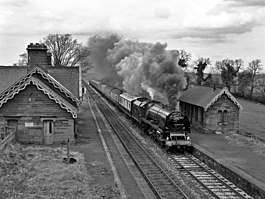Cumwhinton railway station
Cumwhinton railway station was a railway station serving the village of Cumwhinton in Cumbria, England. The station was located on the Settle and Carlisle Line and was closed in 1956. The station is still intact, including platforms, and the station buildings are now grade II listed structures.
| Cumwhinton railway station | |
|---|---|
 46229 Duchess of Hamilton passes the closed Cumwhinton station | |
| Location | |
| Coordinates | 54.8698°N 2.8520°W |
| Grid reference | NY454531 |
| Operations | |
| Original company | Midland Railway |
| Post-grouping | London Midland and Scottish Railway |
| Platforms | 2 |
| History | |
| 1 May 1876 | Station opened |
| 5 November 1956 | Station closed |
| Listed status | |
| Listing grade | II |
| Entry number | 1335564[1] |
| Added to list | 9 March 1984 |
| Disused railway stations in the United Kingdom | |
| Closed railway stations in Britain A B C D–F G H–J K–L M–O P–R S T–V W–Z | |
History
The station was designed by John Holloway Sanders, who designed many of the other stations on the Settle–Carlisle line.[2] It was listed as being a small (or minor) station in the original Midland Railway plans.[3] It was opened with the rest of the on the initial opening of the line in May 1876[4] and had its station buildings on the down line (towards Carlisle). The station is 4 miles (6.4 km) south east of Carlisle[5] and 304 miles (489 km) north of St Pancras railway station in London, via Cudworth and Keighley.[6] The station was afforded a three-road goods shed on the down side[7] and a signal box just north of the station which closed in 1957.[8]
The main station building is made of red sandstone with a slate roof, is privately owned & occupied and is now a grade II listed structure.[1] Additionally, the Midland Railway provided four railway cottages for workers besides the traditional stationmaster's house.[9]
There have been petitions and public appeals to re-open the station to passenger traffic.[10]
References
- Historic England. "Cumwhinton Station (Grade II) (1335564)". National Heritage List for England. Retrieved 23 August 2019.
- "Notes by the Way". The Derbyshire Times and Chesterfield Herald. British Newspaper Archive. 1 November 1884. Retrieved 23 August 2019 – via British Newspaper Archive.
- Baughan 1987, p. 179.
- Mussett 2016, p. 204.
- Padgett, David; Szwenk, John (2013). Bridge, Mike (ed.). Railway track diagrams. book 4, Midlands & North West (3 ed.). Bradford on Avon: Trackmaps. 34C. ISBN 978-0-9549866-7-4.
- Jackson, Allen (2018). Midland Railway Stations. Stroud: Amberley. p. 13. ISBN 978-1-4456-8043-9.
- Jenkinson, D (1980). Rails in the Fells : a railway case study : an account of the origins, characteristics, and contribution of a railway to the landscape, together with an attempt to evaluate its past and present influence on the area through which it passes (2 ed.). Beer, Devon: Peco. p. 114. ISBN 0900586532.
- Mussett 2016, p. 232.
- Mussett 2016, p. 238.
- Jackson, Allen (2015). Contemporary Perspective on LMS Railway Signalling Vol 1. Stroud: Amberley. p. 62. ISBN 978-1-78500-026-3.
Sources
- Baughan, Peter (1987). The Midland Railway North of Leeds (2 ed.). Newton Abbot: David & Charles. ISBN 0-7153-8852-5.CS1 maint: ref=harv (link)
- Mussett, Nigel (2016). Directory of Resources (Settle Carlisle Railway) (PDF) (Report). Settle: The Settle-Carlisle Railway Development Company Limited.CS1 maint: ref=harv (link)
| Preceding station | Historical railways | Following station | ||
|---|---|---|---|---|
| Cotehill | Midland Railway Settle-Carlisle Railway |
Scotby | ||